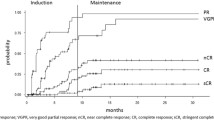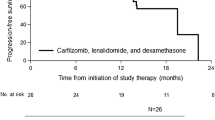Abstract
To investigate whether combination chemotherapy with vincristine, cyclophosphamide, prednisolone, and melphalan (COP/ MP) with the addition of ranimustine (MCNU) (MCNU-COP/MP) is superior to the slightly modified COP/MP (mCOP/MP) regimen in multiple myeloma (MM), a multicenter randomized study was performed. Two hundred ten patients with newly diagnosed, overt MM not treated with chemotherapy were enrolled from 32 institutions of the Lymphoma Study Group of the Japan Clinical Oncology Group and were randomized to receive either MCNU-COP/MP or mCOP/MP. The response rate (RR) to mCOP/MP was 43.7% (95% confidence interval [CI], 33.9%–53.8%] and to MCNU-COP/MP was 56.1 % (95% CI, 46.1 %–65.7%) (P = .097). The progression-free survival (PFS) was significantly longer for patients treated with MCNU-COP/MP than for patients treated with mCOP/MP (median, 23.0 months [95% CI, 18.9–25.8] versus 15.8 months [95% CI, 14.1–19.4]) (P = .014). However, no significant difference in overall survival rate (OS) was observed between the groups (median, 49.9 months [95% CI, 40.4-59.1] versus 44.0 months [95% CI, 32.8–59.8]) ( P = .75). Grades 3 and 4 hematological toxicities were more frequently observed with MCNU-COP/MP than with mCOP/MP, but the incidence of grades 3 and 4 nonhematological toxicities was low in both groups. In conclusion, MCNU-COP/MP in comparison with mCOP/MP improved RR and PFS in overt MM; however, this outcome did not contribute to prolonging OS, indicating that addition of MCNU to mCOP/MP has no benefit on survival.
Similar content being viewed by others
References
Myeloma Trialists’ Collaborative Group. Combination chemotherapy versus melphalan plus prednisone as treatment for multiple myeloma: an overview of 6,633 patients from 27 randomized trials.J Clin Oncol. 1998;16:3832–3842.
Takenaka T, Shirakawa S, Mikuni C, et al. Alternating combination chemotherapy COP (cyclophosphamide, vincristine, prednisolone) and MP (melphalan, prednisolone) in multiple myeloma: a multi- center phase IT study (JCOG8906).Jpn J Clin Oncol. 1999;29:485–489.
Tanaka I, Kobayashi T, Shirakawa S, et al. Phase II study of methyl 6-[3-(2-chloroethyl)-3-nitrosoureoid]-6-deoxy-α-D-glucopyranoside (MCNU) fin Japanese with English summary].Jpn J Cancer Chemother. l985;12:493–498.
Imamura Y, Takagi T, Yawata Y, et al. Combination chemotherapy with MCNU, vindesine, melphalan, and prednisolone (MCNU- VMP therapy) in induction therapy for multiple myeloma.Int J Hematol. 199;4;59:113–123.
Wada M, Mizoguchi H, Kuriya S, et al. Induction therapy consisting of alternating cycles of ranimustine, vincristine, melphalan, dexamethasone and interferon α (ROAD-IN) and a randomized comparison of interferon α maintenance in multiple myeloma: a co-operative study in Japan.Br J Haematol. 2000;l09:805–814.
Durie BGM. Staging and kinetics of multiple myeloma.Semin Oncol. 1986;13:300–309.
Oken MM, Creech RH, Tormey DC, et al. Toxicity and response criteria of the Eastern Cooperative Oncology Group.Am J Clin Oncol. 1982;5:649–655.
Shimoyama M, Fukuda H, Saijo N, Yamaguchi N. Japan Clinical Oncology Group (JCOG).JpnJ Clin Oncol 1998;28:158–162.
Salmon SE, Haut A, Bonnet JD, et al. Alternating combination chemotherapy and levamisole improve survival in multiple myeloma: a Southwest Oncology Group Study.J Clin Oncol. 1983; 1:453–461.
Tobinai K, Kohno A, Shimada Y, et al. Toxicity grading criteria of the Japan Clinical Oncology Group.Jpn J Clin Oncol. 1993;23:250–257.
Kaplan EL, Meier P. Non-parametric estimation from incomplete observations.J Am Stat Assoc. 1958;53:457–481.
Cox DR. Regression models and life-tables.J R Stat Soc Series B. 1972;34:187–220.
Kim K, DeMets DI.. Confidence intervals following group sequential tests in clinical trials.Biometrics. 1987;43:857–864.
Rcboussin DM, DeMets DL, Kim KM, Lan KKG. Programs for computing group sequential boundaries using the Lan-DeMets methods version 2 (1998). Available at: http://www.medsch.wisc. edu/landemets/.
SAS/ATAT Software: Changes and Enhancements for Release 6.12. Gary, NC: SAS Institute; 1997.
Gregory WM, Richards MA, Malpas JS. Combination chemotherapy versus melphalan and prednisolone in the treatment of multiple myeloma: an overview of published trials.J Clin Oncol. 1992;10:334–342.
Attal M, Harousseau J-L, Stoppa A-M, et al. A prospective, randomized trial of autologous bone marrow transplantation and chemotherapy in multiple myeloma.N Engl J Med. 1996;335:91–97.
Siegel DS, Desikan KR, Mehta J, et al. Age is not a prognostic variable with autotransplants for multiple myeloma.Blood. 1999; 93:51–54.
Sirohi B, Powles R,Treleaven J, et al. High-dose chemotherapy and autologous transplantation in myeloma patients aged 65 years and over: a case-control comparison with younger patients.Blood. 1999;94:578a.
Myeloma Trialists’ Collaborative Group. Interferon as therapy for multiple myeloma: an individual patient data overview on 24 randomized trials and 4012 patients.Br J Haematol. 2001;113:1020–1034.
Salmon SE, Crowley JJ, Balcerzak SP, Roach RW, Taylor SA. Interferon versus interferon plus prednisone remission maintenance therapy for multiple myeloma: a Southwest Oncology Group Study.J Clin Oncol. 1998;16:890–896.
Alexanian R, Weber D, Dimopoulos M, Delasalle K, Smith TL. Randomized trial of α-intcrfcron or dexamethasone as maintenance treatment for multiple myeloma.Am J Hematol. 2000;65:204–209.
Singhal S, Mehta J, Desikan R, et al. Antitumor activity of thalido- mide in refractory multiple myeloma.N Engl J Med. 1999;341:1561–1571.
Juliusson G, Celsing F, Turesson I, Lenhoff S, Adriansson M, Malm C. Frequent good partial remissions from thalidomide including best response ever in patients with advanced refractory and relapsed myeloma.Br J Haematol. 2000;109:89–96.
Weber D, Rankin K, Gavino M, Delasalle K, Alexanian R.Thalid- omide alone or with dexamethasone for previously untreated multiple myeloma.J Clin Oncol 2003;21:16–19.
Hussein MA, Elson P, Tose EA, Karam M, Srkaloci G. Doxil (D),vin- cristine (V), decadron (d) and thalidomide (T) (DVd-T) for relapsed/ refractory multiple myeloma [abstract].Blood. 2002(suppl l);100:403a .
Richardson PG, Schlossman RL, Weller E, et al. Imraunoraodula- tory drug CC-5013 overcomes drug resistance and is well tolerated in patients with relapsed multiple myeloma.Blood. 2002;100:3063–3067.
Orlowski RZ, Stinchcombe TE, Mitchell BS, et al. Phase I trial of the proteasome inhibitor PS-341 in patients with refractory hema- tologic malignancies.J Clin Oncol. 2002:20:4420–4427.
Richardson P, Barlogie B, Berenson J, et al. A phase II multicenter study of the proteasome inhibitor bortezomib (Velcade™, formerly PS-341) in multiple myeloma patients with relapsed/refractory disease [abstract].Blood. 2002(suppl l);100:104a.
Zangari M, Barlogie B, Prather J, et al. Marked activity also in del 13 multiple myeloma of PS 341 and subsequent thalidomide in a setting of resistance to post-autotransplant salvage therapies [abstract].Blood. 2002 (suppl l);100:105a.
Pinto OC, Hu E, Bernstein-Singer M, Pinter-Brown L, Govidarajan B. Acute hepatic injury after the withdrawal of immunosuppressive chemotherapy in patients with hepatitis B.Cancer. 1990;65:878–884.
Ohtsu T, Sai T, Oka M, Sugai Y, Tobinai K. Activation of hepatitis B virus infection by chemotherapy containing glucocorticoid in hepa- titis B virus carriers with hematological malignancies.Jpn J Clin Oncol. 199121:360–365.
Yoshiba M, Sckiyama K, Iwabuchi S, et al. Recurrent fulminant hepatic failure in an HB carrier after intensive chemotherapy.Dig Dis Sci. 1993:38:1751–1755.
Fan FS, Tzeng CH, Hsiao KI, Hu ST, Liu WT, Chen PM. Withdrawal of immunosuppressive therapy in allogeneic bone marrow transplantation reactivates chronic viral hepatitis C.Bone Marrow Transplant. 1991;8:417–420.
Fong T-L, Valinluck B, Govindarajan S, Charboneau F, Adkins RH, Redeker AG. Short-term prcdnisone therapy affects aminotrans- ferase activity and hepatitis C virus RNA levels in chronic hepatitis C.Gastroenterology.1994;107:196–199.
Vento S, Cainelli F, Mirandola F, et al. Fulminant hepatitis on withdrawal of chemotherapy in carriers of hepatitis C virus.Lancet. 1996;347:92–93.
Bergsagel DE, Bailey AJ, Langley GR, MacDonald RN, White DF, Miller AB. The chemotherapy of plasma-cell myeloma and the incidence of acute leukemia.N Engl J Med. 1979;301:743–748.
Tucker MA, Coleman CN, Cox RS, Varghese A, Rosenberg SA. Risk of second cancers after treatment for Hodgkin’s disease.N Engl J Med. 1988;318:76–81.
Boffetta P, Kaldor JM. Secondary malignancies following cancer chemotherapy.Acta Oncol. 1994;33:591–598.
Author information
Authors and Affiliations
Consortia
Corresponding author
About this article
Cite this article
Takenaka, T., Itoh, K., Suzuki, T. et al. Phase III Study of Ranimustine, Cyclophosphamide, Vincristine, Melphalan, and Prednisolone (MCNU-COP/MP) versus Modified COP/MP in Multiple Myeloma: A Japan Clinical Oncology Group Study, JCOG 9301. Int J Hematol 79, 165–173 (2004). https://doi.org/10.1532/IJH97.03115
Received:
Revised:
Accepted:
Published:
Issue Date:
DOI: https://doi.org/10.1532/IJH97.03115




